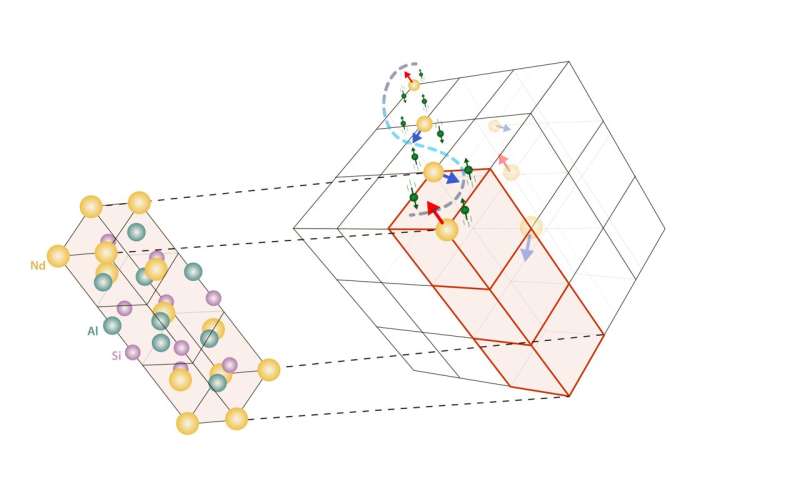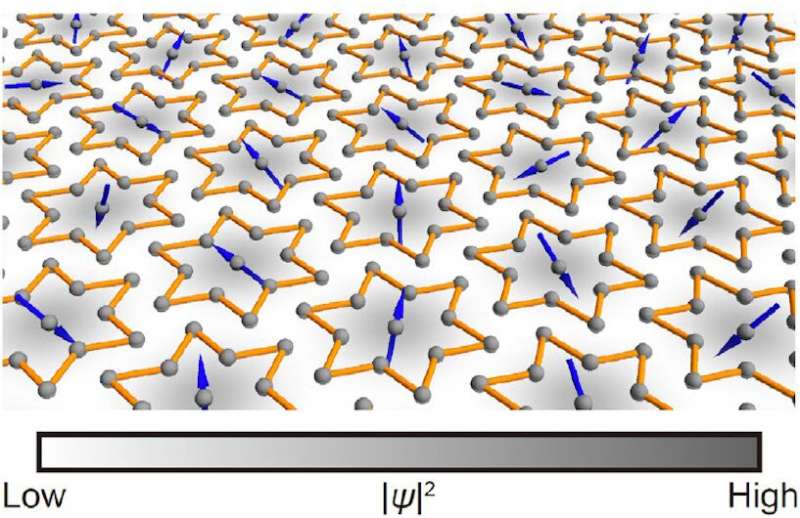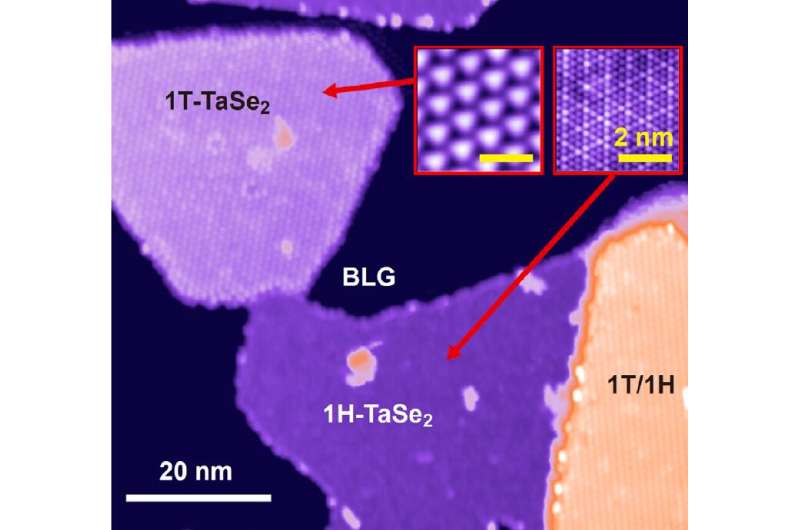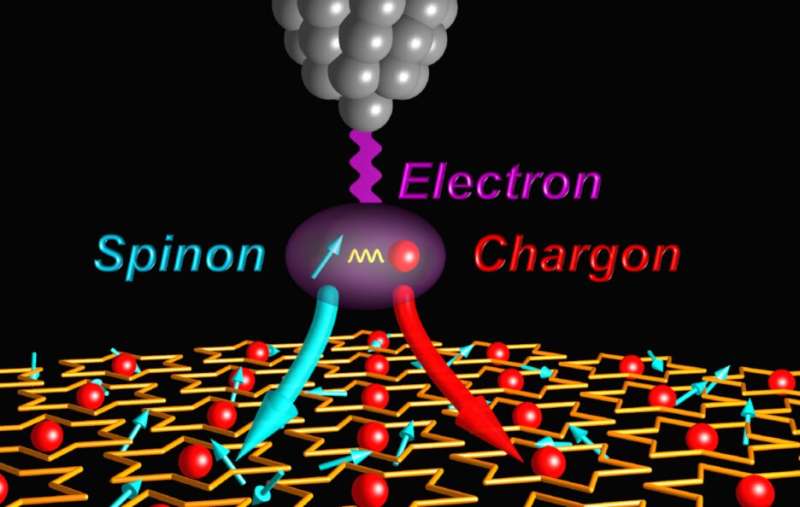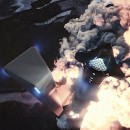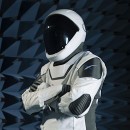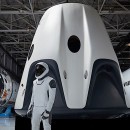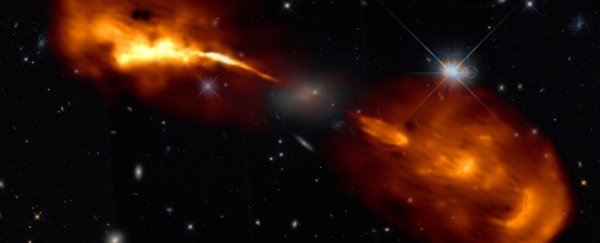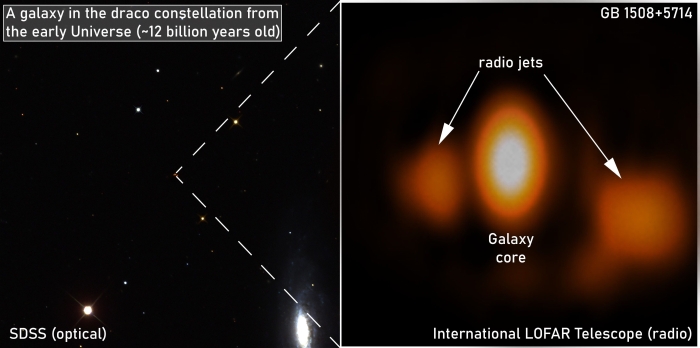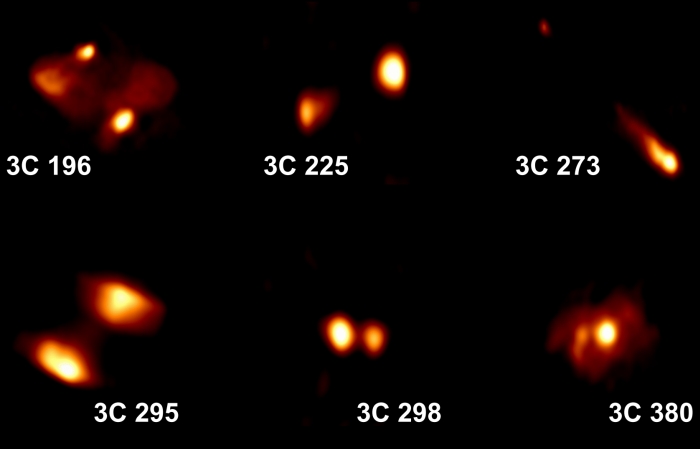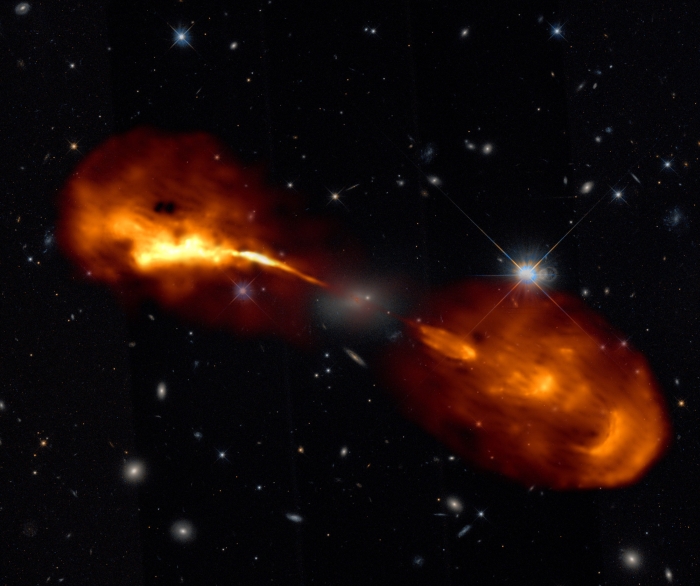By showing that even large objects can exhibit bizarre quantum behaviors, physicists hope to illuminate the mystery of quantum collapse, identify the quantum nature of gravity, and perhaps even make Schrödinger’s cat a reality.
How large can an object be and still act like a quantum wave? In theory, any size at all.
Hannes Hummel for Quanta Magazine
Philip Ball
Contributing Writer
August 18, 2021
VIEW PDF/PRINT MODE
It’s a mere speck of matter — a piece of silica crystal no bigger than a virus, levitated in a light beam. But it is almost as motionless as the laws of physics permit.
Two teams of researchers, in Austria and Switzerland, have independently succeeded in freezing such minuscule nanoparticles, just 100 to 140 nanometers across, almost entirely into their lowest-energy quantum state, giving them effectively a temperature just a few millionths of a degree above absolute zero — and fixing them in place with unearthly precision.
Holding a nanoparticle this tightly in a single spot is just the start. The goal is to put these objects into a so-called quantum superposition — where it becomes impossible to say, before measuring them, just where they are. A particle in a superposition could be found in one of two or more places, and you just don’t know which of them it will be until you look. It is perhaps the most startling example of how quantum mechanics seems to insist that our familiar world of objects with definite properties and positions comes into being only through the act of looking at it.
Superpositions of subatomic particles, atoms, and the massless “particles” of light called photons are well established. But because such quantum effects tend to be very easily disturbed when the particles interact with their surroundings, setting up superpositions gets rapidly harder as the objects get bigger and experience more interactions. Those interactions tend to almost instantaneously destroy a superposition and leave the object with unique, well-defined properties.
All the same, researchers have been steadily increasing the size at which superpositions and related quantum effects can still be observed — from particles to small molecules, then bigger molecules, and now, they hope, nanoscale lumps of matter. No one knows how far in principle this expansion of quantumness can continue. Is there — as some think — a size limit at which it simply vanishes, perhaps because quantum behavior is incompatible with gravity (which is negligible for atoms and molecules)? Or is there no fundamental limit to how big quantumness can be?

A silica nanoparticle has been cooled to its quantum ground state.
Lorenzo Magrini, Yuriy Coroli/University of Vienna
These questions have been around throughout the century-long history of quantum theory. Now, for the first time, researchers are on the cusp of being able to answer them — and perhaps to point the way toward describing how gravity fits into the quantum world. “I’ve been working on macroscopic superpositions for 10 years,” said the quantum theorist Oriol Romero-Isart of the University of Innsbruck in Austria, one of the leaders in the field, “but now we’re at a very timely moment.” In the coming years, we might discover whether or not the world is quantum all the way up.

Aquantum particle in a superposition, contrary to common belief, is not really in two (or more) states at once. Rather, a superposition means that there is more than one possible outcome of a measurement. For an object at everyday scales, described by classical physics, that makes no sense — it is either here or there, red or blue. If we can’t say which it is, that’s just because of our ignorance: We haven’t looked. But for quantum superpositions, there simply is no definite answer — the property of “position” is ill-defined.
If, however, we only see one outcome or the other when we look, how can we know the particle was in a superposition before we looked? The answer is that so long as we don’t try to find out what the outcome is — so long as we don’t measure that property — the two (or more) alternatives somehow embodied in the superposition can interfere with one another, just like two waves. This wavy behavior is embodied in a mathematical entity called the wave function, which encodes everything we are able to say about the particle.
Quantum interference is most famously seen when a particle passes through two narrowly spaced slits in a screen. If we don’t look to see which slit the particle goes through, then the particle will behave much like a water wave, and its wave function will spread through both slits at once, creating an interference pattern.
But if we place a measuring device by a slit to tell us if each particle went through it or not — to observe the particle’s path — then the interference pattern goes away.
How big can objects get and still behave as interfering “matter waves”? The quantum physicist Anton Zeilinger and his co-workers at the University of Vienna studied that question in 1999 with a double-slit experiment using carbon molecules called fullerenes (C60), made from exactly 60 carbon atoms linked into hexagonal and pentagonal rings like the leather patches of a soccer ball. They found a clear interference pattern, demonstrating that even molecules like C60 — at 0.7 nanometers across, much bigger and heftier than an individual atom — could be put into a superposition.
Perhaps just as important, they went on to study how that superposition went away.
Interactions between a quantum particle and neighboring particles, such as gas molecules or photons, entangle both objects into a kind of joint quantum state. In this way, a superposition of the original particle gets spread into the environment.
Rather like an ink droplet diffusing and spreading in a glass of water, this spreading superposition makes it ever harder to see the original one unless you look at every spot it has spread to and reconstruct it from that information. As entanglement mixes the wave function of the initial superposed particle with those of its surrounding particles, the wave function seems to lose coherence and become just a mass of incoherent little waves. This process is called decoherence, and it makes the superposition undetectable in the original object: Its quantum nature seems to disappear.

The high-vacuum chamber of the interferometer in Markus Arndt’s laboratory includes a violet mirror and nanomotors to move the mechanical gratings.
Quantum Nanophysics Group
Decoherence of a quantum superposition happens extremely fast unless the interactions of the particle with its environment can be minimized — for example, by cooling it to extremely low temperatures to reduce the disruptive effect of heat, and keeping the object in a vacuum to eliminate molecular collisions. The bigger the object is, the more interactions it is likely to have, and the faster decoherence happens. For a dust grain about 10 micrometers across floating in the air, a superposition state of two positions in space separated by about the same width as the grain itself is estimated to decohere in about 10−31 seconds — less than the time it takes for a beam of light to travel the width of a proton.
Decoherence seems to be the main obstacle to making quantum superpositions of large objects that last long enough to be observed. The interference experiments with fullerenes lent support to that picture. The Vienna team predicted that the interference of the particles should gradually disappear as they let a background gas into the chamber, where its molecules would collide with the fullerenes and destroy the coherence of their quantum waves. That’s exactly what they saw.
One of the members of Zeilinger’s team was Markus Arndt, who has continued the quest to scale up quantum interference over the past two decades. In 2011, he and his team interfered beams of carbon-based organic molecules with up to 430 atoms each, measuring up to 6 nanometers across. In 2019, they did it with molecules of around 2,000 atoms. Then last year, they created interference patterns in a biological molecule — specifically, a natural peptide called gramicidin A1 — even though these are fragile molecules to submit to the arduous conditions of molecular-beam interference experiments.
Arndt says his goal is to increase the mass of the particles by a factor of 10 every year or two. That would soon take them well into the size and mass range of biological objects such as viruses. Meanwhile, in 2009 Romero-Isart, then at the Max Planck Institute for Quantum Optics in Garching, Germany, and his co-workers sketched out an idea to levitate viruses in an optical trap — where tiny objects are held fast by the forces induced by intense, focused light beams — and then coax them into a superposition of two vibration states and look for interference between them.
Why stop there? The researchers even speculated about doing the same to unambiguously living organisms, such as the phenomenally robust little animals called tardigrades, which are about a millimeter wide and have been found to survive several days of exposure to outer space. The researchers wrote that the plan would allow them to create “quantum superposition states in very much the same spirit as the original Schrödinger’s cat” — the famous thought experiment intended to highlight the apparent absurdity of quantum superpositions for large (and especially living) entities.

The prospect of making Schrödinger’s absurdities into reality is one animating principle behind the Q-Xtreme project, a collaboration between the groups of Markus Aspelmeyer of the University of Vienna, Lukas Novotny and Romain Quidant at the Swiss Federal Institute of Technology Zurich, and Romero-Isart.
In 2019 three of the groups, in two independent studies, reported that they could cool down silica nanoparticles about 100 to 150 nanometers across, containing around a hundred million atoms, almost into their lowest-energy (ground) quantum state while holding them in an optical trap produced by laser beams.
Then last year, Aspelmeyer’s team reported that they had ushered such particles even more fully into the ground state, where the vibrations of the crystalline lattice of atoms are as minimal as they can be. At absolute zero, the particle would be entirely in the ground state, and the only motion remaining would be the so-called zero-point motion of the atoms. In Aspelmeyer’s experiment, the particle was in its ground state 70% of the time on average.
Now in their latest experiments, Aspelmeyer and Novotny have managed to get rid of the optical trap — which affects the quantum behavior of the free particle — so that they can observe the particle “in the wild,” as it were, rather than in captivity. The researchers use laser light to constantly measure the particle’s position, then apply an electric field to nudge the particle so that it stays in its designated location — not by trapping, but by gentle coaxing. This “active feedback” approach suppresses the particle’s thermal jiggling and cools it to an extremely low temperature.
Aspelmeyer’s group says that the spread in their particle’s position is only 1.3 times that of the zero-point motion, equivalent to a temperature of just a few millionths of a kelvin above absolute zero. Novotny and colleagues obtained comparable cooling with a similar setup.


Inside a vacuum chamber in the lab of Lukas Novotny (left), two optical lenses hold a levitated silica nanoparticle (right).
ETH Zurich
The next step will be to make a superposition. In order to do so, the researchers will need to control three key environmental influences. First, they must eliminate any noisiness in the active-feedback potential. Then they need to use a very high vacuum — about 10−11 millibars of pressure — so that there’s almost nothing for the particle to collide with. Finally, they need to stop the particle from radiating any photons — as any warm object does. Though the particle is very tightly localized, as if supercold, it absorbs enough of the photons buzzing around to be at an internal temperature of 1,000 degrees Kelvin or so, which would make it radiate like a hot poker. Suppressing the decoherence induced by that radiation is going to be tough, said Romero-Isart.
The need to suppress radiation from the particle speaks to a subtle yet critical issue. A quantum superposition isn’t destroyed because a disturbance from the environment comes in and knocks it off balance. Rather, it’s destroyed when information about the object’s location leaks out into the environment where it can be measured — just as interference in a quantum double-slit experiment is destroyed by measuring particle paths.
If a gas molecule bounces off it, say, in principle you could figure out where the particle is by looking at the molecule’s trajectory. Or if it radiates photons, you can see where it is just as you can locate your front door at night from the light on your porch. Yet in the case of your front door, the light only reveals its location. For quantum objects, the radiated light creates it.

This sensitivity of a superposition to interactions with the environment makes the experiment hard, but it can also be useful. For example, a system like this could be used to study how quantum objects lose their quantumness through decoherence and become classically fixed in one place. “Large superpositions are very fragile and sensitive to decoherence,” said Romero-Isart — but “decoherence is something we don’t understand completely.” So the experiments could test theories of how it happens.
Researchers are particularly keen to examine one idea about how quantum becomes classical. This switch has long been described as “collapse of the wave function”: A superposition of two possible states, say, collapses to just one of them when measured. This collapse was first proposed by the Hungarian mathematical physicist John von Neumann in the 1930s as an ad hoc way to get from the probabilities encoded in the wave function to the definite values that actual measurements produce. It was a sleight of hand with no real justification from the theory itself: a mathematical convenience to reconcile the theory with what we actually see.
Ideas about decoherence and interaction with the measuring apparatus have now largely replaced von Neumann’s mysterious notion of an abrupt collapse. But some researchers have proposed that collapse is nonetheless a real, physical process that produces classical definiteness from quantum possibilities. “Collapse models predict breakdowns of [standard] quantum mechanics when you have large masses and large superpositions,” said Romero-Isart. “Quantum mechanics has not been tested in that space.”

Kahan Dare (left) and Manuel Reisenbauer, researchers in the lab of Markus Aspelmeyer, work on the experiment to cool levitated nanoparticle to its quantum ground state.Lorenzo Magrini, Yuriy Coroli/University of Vienna
He and his colleagues in Q-Xtreme hope to test physical-collapse models, which predict that large superpositions will be shorter-lived than expected. In particular, they hope to explore what happens to quantum mechanics at size scales where gravity matters.
Right now, quantum mechanics seems incompatible with the modern theory of gravity, namely Albert Einstein’s general relativity. The quantum world is discrete and granular, whereas relativity describes space-time as smooth and continuous. Usually this discord can be ignored, because quantum mechanics describes the very small while general relativity describes large, massive objects.
But the British mathematical physicist Roger Penrose has suggested that at intermediate scales, when quantum theory collides with general relativity, the latter will win, destroying quantum effects. Under general relativity, any object that has a significant gravitational field distorts space-time. But an object in a superposition of locations would then produce two superposed space-times: a situation that general relativity doesn’t allow. So Penrose believes that gravity would force a choice between the alternatives.
Aspelmeyer thinks that Q-Xtreme should finally be able to put theories like this one to the test. “At the scale of our planned experiment, all existing collapse models would either be ruled out or constrained to parameter regimes that render them meaningless,” he said.
Superpositions of masses large enough for gravity to come into play could probe quantum aspects of gravity itself. One idea for doing that is to use gravitational interaction to entangle the masses. In 2017, the physicists Sougato Bose of University College London and Vlatko Vedral and Chiara Marletto of the University of Oxford independently proposed experiments that might do just that. Such experiments are “super exciting but very hard,” said Romero-Isart — although Vedral thinks that it could be feasible in the next 10 years or so.
No one knows quite what to expect. “Once we can study a situation where quantum theory would suggest that space-time itself should be in a superposition of two measurably different states,” said Aephraim Steinberg, a quantum physicist at the University of Toronto, “all bets are off, and we have nothing but experiment to guide us. It’s reasonable to keep an open mind to the possibility that we will discover something new.”
Vedral expects we will find that gravity (at least when it is not super strong) can indeed be described using standard quantum field theory, just like the other known forces. But he admits that “secretly I’m hoping that it would fail, because as a theoretician you would like something extraordinary to happen.”

Attempting large quantum superpositions is a win-win situation, said Bose. If we find that physical collapse prohibits them, that would be a huge discovery about the fundamental nature of quantum mechanics. But if, as many suspect, physical collapse doesn’t occur and the quantum world can just keep getting bigger, then big superpositions, with their extreme sensitivity to sources of decoherence, could act as very delicate sensors. The physicists Jess Riedel and Itay Yavin in Canada, for example, have proposed that quantum systems that are sensitive to gravitational effects might offer a way to look for dark matter particles, which seem to interact with ordinary matter only via gravity. Bose, meanwhile, is interested in using such systems as benchtop detectors of gravitational waves, which so far have only been seen with the aid of immense detectors several kilometers in size.
RELATED:
How Bell’s Theorem Proved ‘Spooky Action at a Distance’ Is Real
Quantum Mischief Rewrites the Laws of Cause and Effect
What Is a Particle?
In other words, expanding the quantum scale up to sizes where gravity matters might teach us new things about quantum mechanics, gravity and hidden aspects of the universe. The project will push technological capabilities to the limit, but the payoff could be enormous. And the current resurgence of interest in creating quantum phenomena such as superposition and entanglement on large scales is not a chance occurrence, said Arndt — because these are precisely what will be needed if we are going to scale up quantum computers so that they have many thousands or even millions of entangled quantum bits. “Quantum technologies will receive dozens of billions of dollars of investments in the coming years,” he said, “and we had better understand the foundations of the theory underlying all these technological hopes.”
